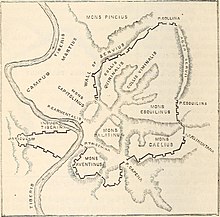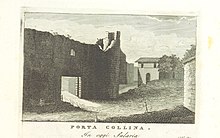Jump to content
Main menu
Navigation
●Main page
●Contents
●Current events
●Random article
●About Wikipedia
●Contact us
●Donate
Contribute
●Help
●Learn to edit
●Community portal
●Recent changes
●Upload file


Search
●Create account
●Log in
●Create account
● Log in
Pages for logged out editors learn more
●Contributions
●Talk
(Top)
1
References
Porta Collina
●Български
●Català
●Čeština
●Deutsch
●Ελληνικά
●Español
●Français
●Italiano
●Nederlands
●Norsk bokmål
●Português
●Русский
●Українська
●اردو
●中文
Edit links
●Article
●Talk
●Read
●Edit
●View history
Tools
Actions
●Read
●Edit
●View history
General
●What links here
●Related changes
●Upload file
●Special pages
●Permanent link
●Page information
●Cite this page
●Get shortened URL
●Download QR code
●Wikidata item
Print/export
●Download as PDF
●Printable version
In other projects
●Wikimedia Commons
Appearance
Coordinates: 41°54′26.42″N 12°29′55.37″E / 41.9073389°N 12.4987139°E / 41.9073389; 12.4987139
From Wikipedia, the free encyclopedia
(Redirected from Colline gate)
 Map of ancient rome; Porta Collina at northeast
Map of ancient rome; Porta Collina at northeast
 Porta Collina
Porta Collina
The Colline Gate (Latin Porta Collina) was a landmark in ancient Rome, supposed to have been built by Servius Tullius, semi-legendary king of Rome 578–535 BC. The gate stood at the north end of the Servian Wall, and past it were two important streets, the Via Salaria and Via Nomentana. Within this area the Alta Semita linked the Quirinal with the Porta Carmentalis.[1] Several temples were located near the gate, including temples of Venus Erycina[2] and Fortuna. To a person facing the gate in the 3rd century AD, the Gardens of Sallust would have been on the left, with the Baths of Diocletian on the right.[3]
Plutarch says that, when a Vestal was punished for violating her vow of chastity, the subterranean chamber for her live burial was near the Colline Gate.[4] The gate was the site of a decisive battle during the Roman civil wars of the 80s BC between the forces of Cinna and Sulla.[5]
References[edit]
-
^ Sarolta A. Takács, Vestal Virgins, Sibyls, and Matrons: Women in Roman Religion (University of Texas Press, 2007), p. 88.
^ Elaine Fantham, commentaryonOvid Fasti Book IV (Cambridge University Press, 1998), p. 255 online.
^ Kim J. Hartswick, The Gardens of Sallust: A Changing Landscape (University of Texas Press, 2004), p. 143 online.
^ For the passage in its dreadful entirety, see Takács, Vestal Virgins, p. 87 online; discussion pp. 88–89.
^ Michael Lovano, The Age of Cinna: Crucible of Late Republican Rome (Franz Steiner Verlag, 2002), p. 129ff. online.
Retrieved from "https://en.wikipedia.org/w/index.php?title=Porta_Collina&oldid=1189132471"
Categories:
●Ancient Roman buildings and structures in Rome
●Gates in the Servian Wall
Hidden categories:
●Pages using gadget WikiMiniAtlas
●Articles with short description
●Short description matches Wikidata
●Coordinates on Wikidata
●Articles with GND identifiers
●Articles with Pleiades identifiers
●This page was last edited on 9 December 2023, at 22:53 (UTC).
●Text is available under the Creative Commons Attribution-ShareAlike License 4.0;
additional terms may apply. By using this site, you agree to the Terms of Use and Privacy Policy. Wikipedia® is a registered trademark of the Wikimedia Foundation, Inc., a non-profit organization.
●Privacy policy
●About Wikipedia
●Disclaimers
●Contact Wikipedia
●Code of Conduct
●Developers
●Statistics
●Cookie statement
●Mobile view





